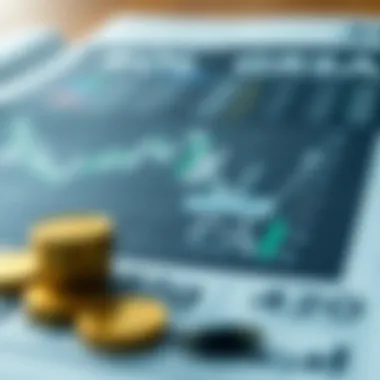Analyzing Dollar to Real Exchange Rate Factors


Intro
The exchange rate between the US dollar and the Brazilian real holds significant importance, not just for traders and investors, but also for understanding the economic landscape of Brazil and the broader South American region. This relationship is intricate, influenced by a myriad of factors ranging from economic indicators, geopolitical events, to market sentiment. It's a dance of currency values that reflects the stability and volatility of two major economies.
As the dollar strengthens against the real, it impacts everything from imports and exports to investor behavior, making it crucial for financial professionals to grasp these dynamics. Knowing how these currencies interact not only aids in effective trading strategies but also allows one to navigate potential pitfalls in the market.
In this article, prospective readers will explore the developmental paths that lead to the current exchange landscape. Understanding the historical data and trends sets the stage for making informed, data-driven decisions. With the rise of cryptocurrency, the parallels and contrasts with traditional exchanges become even more critical.
Market Analysis
Navigating through the present landscape of currency exchange involves thorough market analysis. Investors must keep an eye on the current trends impacting both the dollar and the real, particularly how they are affected by digital currencies.
Current Trends in Cryptocurrency
The rise of cryptocurrency has created ripples in traditional currency markets. Investors are increasingly looking at how these digital currencies relate to fiat money, including the US dollar and Brazilian real. As cryptocurrencies like Bitcoin and Ethereum gain traction, they challenge the conventional roles of money and currency trading. Some key elements to consider include:
- Volatility: Cryptocurrencies often exhibit extreme price volatility, which can influence perceptions of risk in traditional markets.
- Acceptance: The degree to which cryptocurrencies are accepted in the Brazilian market can further affect the demand for the real.
- Regulatory Framework: Brazil's stance on cryptocurrency regulation can either bolster or hinder investment in digital assets, which impacts currency dynamics.
Price Prediction Techniques
Accurate price predictions hinge on understanding both macroeconomic indicators and market sentiments. A few techniques prominent among investors include:
- Technical Analysis: By analyzing historical price patterns and indicators, traders craft forecasts based on past trends.
- Fundamental Analysis: Evaluating economic data such as inflation rates, employment figures, and GDP growth prepares investors for shifts in currency values.
- Sentiment Analysis: Monitoring social media and news for public sentiment can sometimes hint at future currency movements.
"Exchange rates do not only reflect economic realities but also the sentiment of investors and the market’s expectations of future developments."
Investment Strategies
When it comes to investing in currency markets, particularly involving the dollar and real, having a solid strategy can either make giants of profits or save one from hefty losses. Dual approaches often work together: long-term stability versus the rush of short-term gains.
Long-Term vs Short-Term Investing
Investors typically weight their strategies depending on their risk tolerance and market outlook.
- Long-Term Investing: This usually implies holding positions for extended periods, based on fundamental economic strengths and weaknesses.
- Short-Term Investing: This approach is more speculative, oriented around quick trades to capitalize on immediate market fluctuations.
Both strategies can coexist. Depending on the market's behavior, savvy investors adjust their approaches to maximize returns.
Risk Management in Crypto Trading
Risk management forms a crucial backbone in any trading adventure, especially within the realm of volatile assets like cryptocurrencies and foreign exchange. Effective strategies should include:
- Stop-Loss Orders: Setting predefined limits on losses can safeguard against unexpected downturns.
- Diversification: Spreading investments across various assets reduces exposure to any single currency's risk.
- Market Research: Constantly monitoring financial news and economic reports keeps traders informed about potential threats or opportunities in the currency market.
Understanding the dynamics between the US dollar and Brazilian real, alongside the emerging trends in cryptocurrency, creates a roadmap for informed decision-making. It helps in identifying pitfalls and opportunities in this complex yet exciting landscape.
Prolusion to Currency Exchange
Currency exchange serves as a cornerstone of the modern global economy. It enables trade across borders, allowing businesses to sell products and services internationally. When we talk about currency exchange, we are essentially discussing the conversion of one currency into another. The rate at which this exchange occurs is influenced by a myriad of factors including economic performance, geopolitical stability, and market sentiment.
Understanding currency exchange is not just a niche interest for finance professionals—it's fundamental for anyone engaging in global trade. It holds particular significance in the context of the US dollar and the Brazilian real, both of which play critical roles in their respective economies. As we delve deeper into this article, the motivations behind exchanging currencies will become clearer. Knowing how exchange rates function can lead to better investment decisions and provide insights into economic health.
Defining Currency Exchange
Currency exchange involves the process of converting one national currency into another for various purposes, such as tourism, trading, and investment. Imagine planning a trip to Brazil; you would need to exchange your US dollars for Brazilian reais so you can purchase goods and services. But the exchange doesn’t stop there. Investors also partake in currency exchange for profit—buying low and selling high. This aspect of currency exchange creates a market that fluctuates constantly, affected by external factors ranging from economic indicators to political events.
Exchange rates—the value of one currency in relation to another—are determined by supply and demand dynamics in the marketplace. For instance, when the US economy is robust, and there's high demand for the dollar, its value tends to go up. Conversely, if Brazil’s economy shows strength, the real may gain value against the dollar.
Importance of Understanding Exchange Rates
Understanding exchange rates is crucial for several reasons:
- Economic Impact: Exchange rates directly influence inflation, interest rates, and trade balances. A strong dollar can make imports cheaper but hurt export competitiveness.
- Investment Decisions: For investors in foreign markets, knowing the exchange rate can influence buying and selling decisions. A favorable exchange rate can enhance profit margins significantly.
- Risk Management: Currency fluctuations can pose risks for businesses dealing internationally. Awareness of rates allows for strategic planning in hedging practices to mitigate potential losses.
"In the world of global finance, knowledge is a currency itself. Understanding the fluctuations of exchange rates empowers both individuals and businesses alike, allowing them to make informed decisions that can lead to substantial financial benefits."
In sum, the topic of currency exchange offers valuable insights into the pivotal role currencies play in our economies. As we proceed through this article, readers will gain a comprehensive understanding of the complexities involved in the exchange between the dollar and the real, empowering them to navigate the currency markets with enhanced confidence.
The US Dollar: An Overview
The US dollar serves not just as a currency but as a pillar upon which much of the global financial system leans. It’s vital to grasp this context, especially for investors and traders navigating the ever-changing currency landscape. Understanding the role of the dollar illuminates its influence over economic relationships, pricing strategies, and investment decisions.


The dollar’s position as a dominant reserve currency provides guidelines for comprehension. Many countries hold the dollar to stabilize their economies and facilitate international trade. When one looks at the global stage, the dollar stands tall among its peers, acting almost like a benchmark to gauge the health of other economies.
As we delve deeper into this section, we’ll consider how its status impacts exchange rates, trade balances, and even cross-border investments. In the broader picture, knowing the features of the dollar will help elucidate its interplay with the Brazilian real, particularly in terms of investment strategies and market forecasts.
The Dollar as a Global Reserve Currency
The dollar's status as a global reserve currency is nothing short of noteworthy. Reserve currencies are banknotes held in large quantities by governments and institutions for various purposes, such as to back their own currency or to ensure liquidity in foreign exchange markets. The US dollar is held more than any other currency, signifying trust and reliability.
- Liquidity: The dollar’s high liquidity means it can be bought or sold with ease in the foreign exchange markets without significantly affecting its value.
- Stability: The backing of the U.S. economy, with its diverse sectors and stable political influence, bestows a sense of stability that investors cherish in turbulent times.
- Standardization: Many commodities, from oil to gold, are priced in dollars, leading to widespread adoption across the globe.
This prominence also attracts foreign capital into U.S. financial markets, influencing how other currencies behave. For Brazil, the heavy-dollarization in global trade means that fluctuations in the dollar can directly impact the strength of the real.
Economic Indicators Influencing Dollar Strength
Diving into economic indicators provides a lens through which one can assess dollar strength. Various metrics serve as barometers for investors, guiding decisions whether to hold, buy, or sell currency. The backdrop includes:
- Gross Domestic Product (GDP): An increasing GDP often signals a healthy economy, bolstering confidence in the dollar.
- Employment Rates: Low unemployment figures typically coincide with stronger economic performance, reinforcing dollar value.
- Inflation Rates: Moderate inflation can suggest a growing economy, but if inflation soars, it might lead to a decrease in dollar strength as purchasing power weakens.
- Interest Rates: The Federal Reserve’s monetary policy influences interest rates heavily. Higher rates often attract foreign capital, increasing demand for the dollar.
These indicators provide valuable insights into the dollar's trajectory, especially in spotting trends that could affect the dollar-real conversion. Emerging data can create ripples in exchange rates, a critical factor for any investor looking to optimize their holdings.
Understanding how these economic markers interconnect allows investors to navigate the often turbulent waters of currency exchange more effectively. Grasping this can pave the way for well-informed decision-making.
In summary, the US dollar stands as a critical figure in global finance. Its status as a reserve currency, along with economic indicators shaping its strength, creates a complex yet fascinating dynamic that necessitates thorough analysis for those engaged in currency exchange.
The Brazilian Real: Context and Significance
The Brazilian real plays a pivotal role not only within Brazil but also across the entire Latin American continent. Its significance is rooted deeply in historical context, economic stability, and global trade dynamics. The real, adopted in 1994, replaced the cruzeiro and aimed to stabilize an economy plagued by hyperinflation. Since its implementation, the real has become a currency of choice for transactions, investments, and trade in the region.
One major factor to consider is the real's influence in trade relations. Given Brazil's position as a leading exporter of agricultural products like soybeans and coffee, the currency's strength or weakness can have profound implications on trade balances. A strong real might reduce the competitiveness of Brazilian exports, while a weakened real could make Brazilian goods more attractive to international buyers, hence increasing exports.
Furthermore, understanding the dynamics of the real is crucial for investors. As the global marketplace becomes more interconnected, fluctuations in the real’s value can significantly impact portfolio performances, especially for those with investments in emerging markets. The real's relationship with other currencies can shed light on broader economic conditions and investor sentiments.
In essence, the Brazilian real serves as a barometer of economic health in Brazil and reflects the country’s engagements on the global stage. Given its expanding role in global trade and investments, gaining insights into the real's dynamics is invaluable for analysts and investors looking to make informed decisions in the increasingly competitive currency landscape.
The Role of the Real in Latin America
The Brazilian real is crucial within the Latin American economic fabric. It’s not just about Brazil; the health of the real impacts neighboring currencies and economies. For instance, significant shifts in the real often lead to ripple effects felt from Argentina to Chile.
- Regional Trade: Brazil is a powerhouse in South America. The volume of trade among its neighbors is heavily influenced by the strength of the real. For instance, countries that import Brazilian goods will find their trade balances affected as the real fluctuates.
- Investment Flow: Investors watching the Latin American market closely consider the Brazilian economy a bellwether. Changes in the real can attract or repel foreign investment across the region, with investors keen to minimize risks associated with currency volatility.
- Political Relations: The real’s stability is often seen as a reflection of Brazil's political landscape. Unrest can lead to rapid changes in exchange rates, which in turn can influence regional stability.
These factors underline the importance of monitoring the real, especially for investors and analysts looking to navigate the complex economic terrain of Latin America.
Key Economic Factors Affecting the Real
Understanding what drives the real is critical for anyone invested in or analyzing Brazil’s economy. Several key economic factors impact the valuation of the Brazilian real:
- Inflation: Inflation rates in Brazil are a primary determinant of the real's strength. A higher inflation rate generally erodes purchasing power and can lead to a depreciation of the real. Keeping track of the IPCA (Índice Nacional de Preços ao Consumidor Amplo) helps gauge inflation trends.
- Interest Rates: The Selic rate, established by the Central Bank of Brazil, plays a significant role. Investors often look to interest rates to determine returns on investments. Higher interest rates can attract foreign capital and strengthen the real.
- Fiscal Policies: Government policies regarding spending, taxation, and public debt are other essential elements influencing the currency. A sound fiscal strategy tends to create confidence among international investors, serving to bolster the value of the real.
- Commodity Prices: Brazil is a major exporter of commodities, so international prices for commodities like iron ore and agricultural goods directly affect the real. For instance, a rise in soy or iron ore prices can lead to appreciation of the currency due to increased export revenues.
In summary, comprehending the interplay of these factors is essential for making sense of the real’s value. Investors need to stay informed about the economic developments to navigate the environment effectively.
Factors Affecting the Dollar-Real Exchange Rate
Understanding the dynamics of the dollar to real exchange rate requires a keen eye on several critical factors. This section delves into the nuances that cause shifts in the currency exchange, laying out the framework for analysis and application in real-world scenarios. Investors and analysts should grasp these elements thoroughly, as they often dictate the behavior of the currency markets.
Inflation Rates and Their Implications
Inflation isn't just a buzzword; it plays a pivotal role in determining currency strength and ultimately the dollar-real exchange rate. Brazil, historically grappling with higher inflation rates, often witnesses depreciation of the real against the US dollar. When inflation accelerates and excites the markets, buying power decreases. In 2022, Brazil's inflation rate surged to notable highs, leading many investors to shift their focus to the dollar, considered a safer haven.
The implications are significant for investors:
- Diminished Purchasing Power: As inflation rises, the value of the real diminishes, making imported goods more expensive. This can subsequently increase the demand for dollars worldwide.
- Export Competitiveness: While higher inflation can hurt domestic consumers, it may empower Brazilian exporters, whose goods become cheaper abroad. However, this can also create volatility in the exchange rate.
- International Investments: With inflation on the rise, foreign investments may decline, placing additional pressure on the real as investors flock to more stable currencies.
Given these factors, monitoring inflation trends provides keen insight into potential fluctuations in the dollar-real exchange rate.
Interest Rate Differentials
Interest rates serve as a barometer for currency valuation. To keep a stable economy, Brazil and the United States often adjust their rates in response to inflation and economic growth. Higher interest rates in Brazil compared to the United States tend to attract global investors seeking better returns on their investments, thus strengthening the real.
However, the interplay can be quite intricate:
- Capital Flows: An increase in Brazil’s interest rates could lead to an influx of foreign capital, bolstering the real. Likewise, if US rates are more favorable, capital could flow back, weakening the real against the dollar.
- Consumer Loans: As rates affect consumer spending, the population's ability to invest in goods and services will sway the economy, impacting exchange rates indirectly.
- Speculation: Market speculation often reacts to changes in interest rates. Investors may buy or sell positions in the dollar-real pair based on anticipated rate movements, increasing volatility.


Awareness of interest rate movements is essential for traders who want to make informed decisions in the evolving currency exchange landscape.
Political Stability and Economic Policies
The socio-political landscape can make or break a currency. Political stability in Brazil contributes to investor confidence, while instability can lead to drastic movements in the dollar-real exchange rate. Economic policies and reforms, such as fiscal policy adjustments or changes in trade agreements, foster or hinder development, affecting the real's strength.
Key considerations include:
- Political News and Events: Major events, such as elections or policy changes, can influence market sentiment and cause abrupt fluctuations in the exchange rate. For instance, the Brazilian elections in 2022 brought uncertainty, leading to a bearish sentiment around the real.
- Government Actions: A well-structured economic policy can yield confidence among investors, while erratic policies may drive them away, resulting in depreciation of the real against the dollar.
- Global Events: Beyond national borders, international relations and global crises can affect exchange dynamics. For example, trade tensions or foreign sanctions can instigate a flee to safety in the form of the US dollar.
To navigate the currency market, investors must not only keep an eye on local events but also on global political relationships and their economic implications.
"Understanding the interplay of these factors not only aids in predicting short-term currency movements but also helps in formulating long-term investment strategies."
By thoroughly examining these elements affecting the dollar-real exchange rate, stakeholders can position themselves strategically, ensuring resilience in fluctuations and uncertainties inherent in the currency market.
Historical Exchange Rate Trends
Understanding the historical exchange rate trends between the US dollar and the Brazilian real is paramount for investors and analysts keen on grasping the shifting dynamics of currency exchange. These trends reveal how historical events, economic policies, and market behaviors collectively shape current and future exchange rates. Through awareness of past movements, traders can forecast potential fluctuations, enabling them to make informed decisions amidst volatility.
Analysis of Historical Performance
When looking at the historical performance of the dollar in relation to the real, several key factors come into play. One major element is pricing history; fluctuations over time can often reveal patterns that inform current market behavior.
- Strong Dollar vs. Weak Real: In periods when the dollar is strong, imports become cheaper for Americans, while Brazilian exports may falter. This was evident during the global financial crisis of 2008, where the dollar surged as a safe haven, impacting the real negatively.
- Currency Valuation Shifts: The valuations oscillate based on Brazilian inflation rates and fiscal policies. For instance, when inflation in Brazil skyrocketed in the early '90s, the real depreciated sharply against the dollar, creating an opportunity for those investing at the lower exchange rates.
Moreover, the volatility of the Brazilian economy has contributed to sharp swings in the exchange. A sudden political scandal or a change in government policy can lead to swift depreciation of the real. Historical data encapsulated in exchange histograms provides a clearer picture of these fluctuations—these figures are crucial for analyzing cyclical trends versus structural changes in the economy.
Major Events Shaping Exchange Rates
Several critical events have dramatically shaped the exchange rate between the dollar and the real. Understanding these can give traders insights into what might happen in the future.
- 1994 Real Plan: One could argue that the introduction of the Plano Real was a pivotal moment. This plan drastically changed the Brazilian economy by stabilizing it, resulting in the real being pegged to the dollar initially. This created a foundation that guided financial flows into Brazil and stabilized the currency for a time.
- Global Crises: The 1998 Asian financial crisis had ripple effects on emerging markets, including Brazil. The sudden demand for US dollar liquidity drove down the value of the real, reflecting the vulnerabilities of emerging economies.
- Political Turbulence: More recent events, like the political unrest and the impeachment of President Dilma Rousseff in 2016, caused investors to be wary, leading to rapid capital outflows and depreciation of the real. In such cases, one can observe market sentiment translating approximate global health into local currency strength.
It’s essential to note that the interplay of these historical factors continues to influence the current dollar-to-real dynamics. Utilization of this information allows investors to position themselves more strategically in the market.
"Historical trends are not merely a guide; they are a roadmap for navigating the complexities of currency exchange."
For further resources on the historical background of these currencies, visit Wikipedia and Britannica.
By analyzing these historical performances and events, traders gain invaluable insights into how to navigate today’s currency landscape and make informed investment decisions.
Current Market Conditions
Understanding the current market conditions is essential for anyone involved in currency exchange, especially when it comes to the dollar to real dynamics. The world of currency trading is volatile, influenced by a mix of economic indicators, geopolitical events, and market sentiment. Essentially, knowing the present landscape is as crucial as the strategies one employs for trading or investing.
Recent Trends in the Dollar-Real Pair
In recent months, the dollar to real exchange rate has shown significant fluctuations. The US dollar's strength has been attributed to factors like solid economic data coming from the United States, including lower unemployment rates and strong GDP growth. On the flip side, the Brazilian real faced pressures due to ongoing concerns about political instability and inflation rates that have been stubbornly high.
For instance, in mid-2023, the dollar to real rate saw a spike as the US Federal Reserve signaled more increases in interest rates, subsequently attracting international investors seeking higher yields. Conversely, Brazil dealt with concerns regarding its fiscal policy and inflationary pressures, leading to a weaker real.
Here's a snapshot of some key trends affecting the exchange rate:
- The strengthening dollar driven by fed monetary policy changes
- Brazilian inflation reporting over 6%, urging caution among investors
- Ongoing political debates affecting investor confidence in Brazil
This highlights how interconnected the two currencies are, reacting not only to their respective domestic situations but also to global financial trends.
Market Sentiment and Predictions
Market sentiment plays a crucial role in driving exchange rate dynamics. Often, traders' perceptions about future movements can create a self-fulfilling prophecy. Analysts suggest that if the sentiment leans toward a stronger dollar based on anticipated US economic performance, this could prompt traders to hoard dollars, thus driving up the exchange value against the real.
In early 2024, sentiment was somewhat mixed. Some analysts were predicting that the Brazilian government would enact measures to stabilize inflation and improve economic fundamentals, potentially boosting the real's strength. Others remained skeptical, citing political risks that could hamper effective reforms.
Investor behavior often shifts based on the prevailing sentiment, leading to fluctuations in trading volumes:
- When investors feel optimistic about the dollar,
- Conversely, when concerns about Brazilian inflation arise,
- They may buy more dollars, anticipating appreciation.
- Some traders might liquidate their holdings in real to reduce potential losses.


Overall, keeping a finger on the pulse of market sentiment is crucial when navigating the dollar to real exchange dynamics. It’s these subtle shifts in perception, influenced by economic data and political developments, that can provide insights into potential future movements in the currency pair.
"In currency exchange, understanding sentiment can sometimes prove more prescient than the numbers themselves."
For further details, refer to Investopedia for deeper insights into foreign exchange dynamics and trading strategies.
Investment Strategies in Currency Exchange
Investment strategies around currency exchange are not just darts thrown at a board, but rather a meticulous science entwined with the art of perception. When it comes to trading one currency against another—like the US dollar against the Brazilian real—there’s much at stake. Understanding these strategies becomes essential, especially for those looking to optimize their financial portfolios and enhance their investment returns.
Firstly, having a robust strategy means preparing for the unpredictable nature of foreign exchange markets. Investors need to consider fluctuating geopolitical conditions as well as economic indicators that impact exchange rates. A deep comprehension of market dynamics forms the backbone of any successful exchange strategy.
Some key aspects to consider:
- Understanding Market Sentiment: Recognizing market sentiment helps in anticipating market moves. This sentiment can be shaped by economic news releases, political events, or even social media trends around the dollar or real.
- Technical Analysis: Utilizing tools like moving averages can assist traders in predicting future movements based on historical trends. Patterns on price charts can signal potential buy or sell opportunities.
- Fundamental Analysis: Keeping an eye on economic indicators such as GDP growth rates, inflation, and employment figures in both the US and Brazil is vital. A sudden shift in these indicators can lead to drastic changes in the dollar-real exchange rate.
Overall, having concrete strategies for currency exchange reduces emotional decision-making, which is often the foe of any seasoned trader.
Trading Techniques for Dollar-Real Exchange
When engaging in the dollar-real pair, traders can employ various techniques tailored to their risk tolerance and investment goals. Here are a few popular methods:
- Day Trading: This involves buying and selling within the same trading day. Traders capitalize on small price movements that occur throughout the day, requiring keen observation and quick decision-making. It's not for the faint-hearted.
- Swing Trading: Here, investors buy or sell currency pairs over a period of days or weeks, aiming to profit from potential price fluctuations. It's a more relaxed alternative to day trading, allowing for thorough analysis and a better grasp of market conditions.
- Scalping: This is a rapid-fire strategy where traders make dozens of trades in a single day, aiming to profit from minor changes in the market. Scalpers need to have speed and precision, often working with real-time data.
- Hedging: Investors can also protect their investments from adverse movements in the exchange rate through hedging strategies. This may involve using options or futures contracts to lock in prices.
Risk Management Practices
Risk management is the unsung hero of any trading operation.
Without a solid risk management plan, even the most promising strategies can go awry. Here are some practices that can help mitigate risks when trading the dollar-real:
- Setting Stop-Loss Orders: Placing stop-loss orders ensures that positions are closed automatically once they reach a certain set loss limit. This can prevent devastating losses in volatile markets.
- Position Sizing: Determining the right size for each trade depends on the overall investment capital and risk tolerance. A general rule of thumb is to risk no more than 1-2% of total capital on a single trade.
- Diversification: Don’t put all eggs in one basket. To spread risk, consider diversifying investments across different currency pairs or financial instruments.
- Continuous Learning: Markets are in a constant state of flux. Staying informed about global economic trends, geopolitical developments, and technological advancements in trading methods can pay off enormously.
"An ounce of prevention is worth a pound of cure." This saying rings especially true in currency trading. The cost of being unprepared can far outweigh the price of investing time and energy into robust risk management planning.
Investment strategies are crucial in navigating the complex landscape of currency exchange. By embracing various trading techniques and implementing thorough risk management practices, investors can enhance their potential for success in the dollar-real exchange market.
The Future of the Dollar-Real Exchange Rate
The future trajectory of the dollar-to-real exchange rate holds significant implications not just for traders but for anyone with a vested interest in the economic landscape. Understanding it means grasping potential shifts in not only currency values but also broader economic health between the United States and Brazil. Investors and analysts alike look for signs that could indicate both opportunities and threats in the market. A keen awareness of how this exchange rate evolves can lead to better decisions—whether you're hedging investments, exploring international trade ventures, or simply interested in global economics.
Economic Forecasts and Projections
In examining economic forecasts for the dollar-real exchange rate, one must consider a variety of macroeconomic factors. These include inflation rates, GDP growth, employment figures, and central bank policies. To narrow it down:
- Inflation and Purchasing Power: Brazil's inflation rates have historically fluctuated greatly, showing a tendency to impact the real significantly against the dollar. If Brazil experiences higher inflation compared to the U.S., the real might depreciate, making it more expensive for consumers and businesses that rely on dollar-denominated imports.
- Economic Growth Trends: A robust economic forecast for Brazil can strengthen the real. In a scenario where investments surge—perhaps driven by advancements in industries or agricultural exports—one could see a bullish outlook for the real.Meanwhile, stability and growth in the U.S. economy often provide a solid backbone for the strength of the dollar, leading to a delicate balance that investors must monitor closely.
"Forecasting exchange rates is more an art than a science, influenced by countless variables and unpredictable events."
- Central Bank Policies: The respective central banks' monetary policies also play a major role. For instance, if the Brazilian Central Bank raises interest rates to combat inflation while the U.S. Federal Reserve holds steady, the dollar may weaken against the real as investors seek higher returns in Brazil.
Potential Disruptions in the Currency Market
However,, any outlook based on forecasts must be tempered with an understanding of potential disruptions that could derail expectations. Some key elements to consider include:
- Geopolitical Events: Political instability, trade disputes, or economic sanctions can create sudden shifts in currency strength. For instance, if Brazil faces political turmoil, it could lead to a sudden depreciation of the real, contrary to previous forecasts.
- Commodity Price Shocks: As Brazil is a major exporter of commodities like soybeans and iron ore, fluctuations in global commodity prices can greatly influence the real. A drop in these prices may weaken the real, while a surge can do the opposite, often at unexpected moments.
- Economic Downturns: Unexpected economic downturns in either country can shift market sentiments rapidly. Traders often react quickly to negative news, causing currency values to swing wildly within short periods of time.
In sum, predicting the future of the dollar-real exchange rate is a blend of analyzing concrete economic data while also remaining vigilant about unforeseeable disruptions. Keeping an eye on these factors provides a more nuanced understanding of where the currency market might be heading, creating informed strategies for both short-term and long-term investors.
Epilogue
As we draw the curtain on this comprehensive examination of the dynamics between the US dollar and the Brazilian real, it’s crucial to reflect on the diverse elements that shape this financial relationship. The significance of understanding exchange rate movements, particularly in the context of these two currencies, cannot be understated. Knowledge in this domain not only aids investors and traders but also empowers analysts and educators to make informed decisions in their respective fields.
Recap of Key Insights
Throughout this article, we've highlighted several key factors. First, we examined the major economic indicators such as inflation, interest rates, and political conditions that play pivotal roles in influencing the dollar-real exchange rate. Inflation rates in Brazil, for example, often lead to fluctuations in investment flow as traders adjust their expectations based on the Brazilian Central Bank’s monetary policy.
Additionally, we discussed historical trends that provide context. Many events throughout history, from political upheavals to global economic crises, have influenced this exchange behavior. For instance, the impact of the COVID-19 pandemic prompted a wave of currency shifts that are still being analyzed today.
Lastly, investment strategies for effectively navigating this currency market were outlined. By addressing risk assessment and trading techniques specifically tailored to the dollar-real exchange, we’ve banked on practical insights that equip market participants to take action based on real-world conditions.
Final Thoughts on Economic Trends
Looking ahead, the future of the dollar-real exchange remains uncertain, yet ripe with opportunity. Factors ranging from geopolitical tensions to evolving economic policies in either country will continue to mold the landscape. As we find ourselves in a global market that leaves little room for complacency, being attuned to these shifts is essential.
Furthermore, as technology evolves, the role of digital currencies and blockchain technology may very well revolutionize how we perceive and engage with currency exchanges. While traditional economic principles remain relevant, new trends could reshape strategies and tools for investment in unexpected ways.
"Understanding currency dynamics today ensures you're not just a bystander in tomorrow's economic chess game."
For further reading on currency exchange and investment strategies, resources such as Investopedia and Bloomberg provide valuable information and updates.















